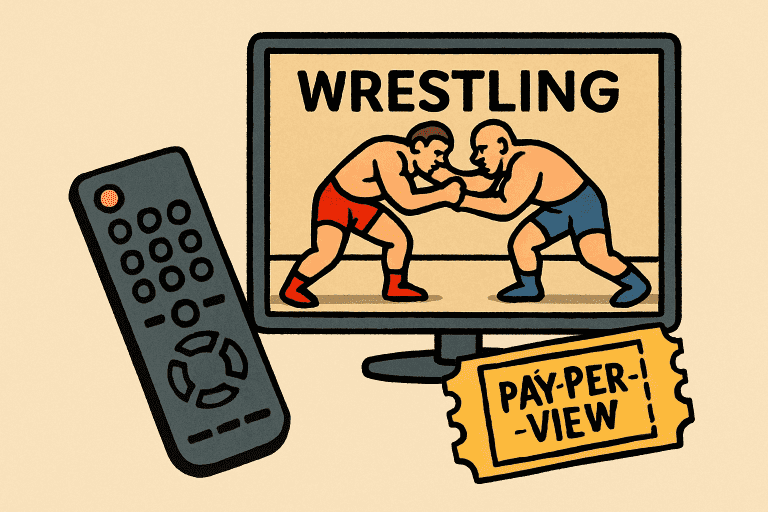Sports
Pioneering Pay-Per-View: How Wrestling Changed Television Consumption
Published
4 months agoon
The rise of pay-per-view in live entertainment, particularly professional wrestling, revolutionized television consumption and revenue models. Wrestling promotions transformed major events into premium, must-watch spectacles, reshaping television consumption and media companies’ audience engagement strategies. This shift, marked by access, exclusivity, and storytelling, created a new viewing experience that continues to impact digital media today. This bold experiment influenced sports and entertainment, influencing media companies’ approaches to audience engagement.
Few industries have experienced as many fundamental shifts in how they reach their audiences as professional wrestling. The vision of innovative promoters, notably Vince McMahon, catalyzed a series of transformations that would ultimately redefine how millions of fans experienced live events and televised entertainment. Wrestling’s unique blend of athleticism and spectacle lent itself perfectly to new broadcast mediums—from closed-circuit arenas to global streaming. The ripple effects of these changes weren’t contained to wrestling alone. Pay-per-view (PPV), first scaled by wrestling, became a key driver not just for combat sports but also for concerts, comedy events, and major sporting spectacles, meaning this sport didn’t just entertain—it helped build the foundation of modern TV consumption habits.
The Birth of Pay-Per-View in Wrestling
During the early 1980s, television and pro wrestling were transforming. Forward-thinking promoters saw the potential in bringing major wrestling events to audiences far beyond arenas. This led to the first truly large-scale closed-circuit broadcasts, where fans flocked to theaters and large venues to watch matches that were happening live elsewhere.
The watershed moment came in 1985 with WrestleMania’s inaugural broadcast. While millions enjoyed the show via closed circuit, a select number watched from home through the nascent PPV format. This was more than a business gambit; it was transformative, opening a new, lucrative revenue stream and allowing promotions to connect with a genuinely national—soon international—audience. The show’s resounding financial and cultural success convinced TV and entertainment executives that demand for “event television” was real.

Wrestling’s Role in Popularizing PPV
Wrestling companies adopted a model of annual “supercards” in the 1980s, focusing on multimedia spectacles with celebrity appearances, musical performances, and unforgettable storylines. WrestleMania III in 1987 attracted over 93,000 attendees and generated massive PPV buys, demonstrating the unique draw power of wrestling events. As wrestling’s PPV numbers grew, other sports and entertainment industries, including boxing, MMA, concerts, and theater events, began experimenting with and profiting from the PPV model developed in the wrestling world. This was about broadcasting and building anticipation and a sense of shared, national appointment viewing.
Transition to Digital Platforms
Faced with changing consumer habits and new technologies, wrestling again reinvented its delivery. The introduction of the WWE Network in 2014 was a landmark moment, allowing fans to stream live events and enjoy a massive library of content for a monthly subscription fee.
The new streaming model fundamentally altered the business landscape. Instead of paying individually for every event, fans had unlimited access—with the added bonus of classic matches and original programming. This move was widely seen as a testing ground for the future of broadcasting.
Impact on Television Consumption
The wrestling industry has routinely been willing to experiment with new formats and revenue models. Its early adoption of PPV and subsequent shift toward streaming set crucial precedents for the growing ecosystem of sports and entertainment content. Where wrestling led, other genres soon followed: more live sports are offered via streaming, traditional channels invest in premium digital content, and event-based programming is at an all-time high.
The way viewers conceive of “television” has been reshaped, thanks in part to professional wrestling’s always-on approach to audience engagement. The modern emphasis on subscription models, live interactivity, and exclusive content can be traced directly to the evolution of wrestling’s business model.
Conclusion
Professional wrestling’s progression from closed-circuit broadcasts to on-demand streaming is a story of entertainment innovation and a broader lesson in media disruption. Today’s television landscape—with its countless subscription services, modular content access, and premium event experiences—owes more than a little to wrestling’s pioneering spirit. By continually embracing change, wrestling has not only stayed relevant but also set the standard for how audiences discover, enjoy, and participate in televised entertainment.

You may like

Eczema, Psoriasis, and Allergies in Winter: Understanding Triggers and Treatments

Tip to Benefit Maximally From Your Tow Truck Course

Esports Arena Network Design: 1,000‑Seat LAN & AV Setup (2025 Guide)

Why Jeep Owners Are Switching to Automatic Tops Like eTop

Comparing Demat Account Providers: Which One Should You Choose?

How Anti‑Cheat SDKs Work (Kernel vs User Mode)

NDI vs SRT vs RTMP (2025): Which Stream Protocol Gives You the Lowest Latency for Esports Broadcasts?

New 240Hz 1440p Panels: What Changes for Players

From Chaos to Clarity: How Data Lake Zones Organize the Modern Data Stack

